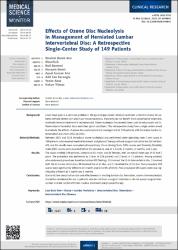Effects of ozone disc nucleolysis in management of herniated lumbar intervertebral disc: A retrospective single-center study of 149 patients

View/Open
Access
info:eu-repo/semantics/openAccesshttp://creativecommons.org/licenses/by-nc-nd/3.0/us/Date
2024Author
Atçı, İbrahim BurakTürk, Okan
Demirel, Nail
Demir, Hüseyin
Atçı, Aysel Gürcan
Karaoğlu, Adil Can
Abut, Fatma Yeşim
Yılmaz, Hakan
Metadata
Show full item recordAbstract
Background: Lower back pain is a common problem in the general population. Medical treatment is the first choice for patients without severe pain and major motor weakness. If patients do not benefit from conservative treatment, minimally invasive treatment is recommended. Ozone nucleolysis has recently been used to reduce pain and inflammation in herniated discs and other spinal conditions. This retrospective study from a single center aimed to evaluate the effects of ozone disc nucleolysis in the management of 149 patients with herniated lumbar intervertebral discs from 2022 to 2024. Material/Methods: Between 2022 and 2024, intradiscal ozone nucleolysis was performed under operating room C-arm scopy in 149 patients who received medical treatment and physical therapy without surgical indication but did not benefit, and the results were evaluated retrospectively. Visual Analog Scale (VAS) scores and Oswestry Disability Index (ODI) scores were recorded before the procedure, and at 1 month, 3 months, 6 months, and 1 year. Results: The study enrolled 149 patients, comprising 61 males and 88 females, with an overall mean age of 43.9±4.7 years. The procedure was performed as 1 level in 138 patients and 2 levels in 11 patients. Among patients who underwent procedures based on lumbar MRI findings, 15 involved the L3-L4 intervertebral disc, 3 involved both the L3-L4 and L4-L5 discs, 90 involved the L4-L5 disc, and 31 involved the L5-S1 disc. Post-procedure VAS scores were significantly different at 1 month and 6 months (P<0.05). Post-procedure ODI scores were also significantly different at 1 month and 6 months. Conclusions: Due to its low complication rate and effectiveness in treating lumbar disc herniation, ozone chemonucleolysis should be considered for use in patients who do not have a surgical indication or do not accept surgical intervention and did not benefit from medical treatment and physical therapy.
Source
Medical Science MonitorVolume
30Issue
July 2024Collections
The following license files are associated with this item:


















